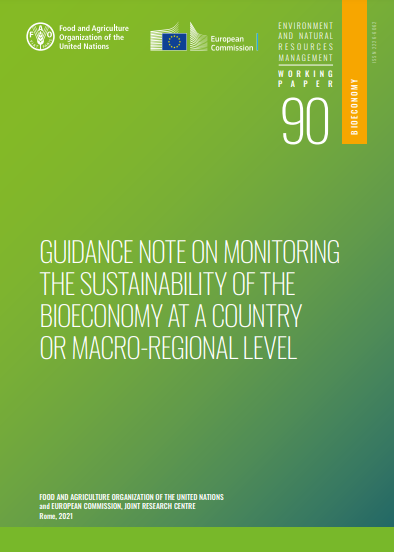
The Food and Agriculture Organization of the United Nations (FAO) and the European Commission’s Joint Research Centre (JRC) today launched an important new bioeconomy publication for policymakers in countries and macro-regions. The Guidance note on monitoring the sustainability of bioeconomy at a country or macro-regional level, which was commissioned by the International Bioeconomy Forum (IBF) and released to coincide with the IBF plenary meeting on 29-30 November 2021, for the first time describes in easy-to-follow steps how countries and macro-regions, such as the European Union (EU), can monitor sustainability along with their bioeconomy strategies and policies.
What is the bioeconomy and why is monitoring of bioeconomy sustainability important?
The bioeconomy has been described as the production, utilization, conservation, and regeneration of biological resources, including related knowledge, science, technology, and innovation, to provide sustainable solutions (information, products, processes and services) within and across all economic sectors and enable a transformation to a sustainable economy. The bioeconomy encompasses the primary production sectors (crop and livestock production, forestry, fisheries and aquaculture) and the ecosystems that supply the primary materials and services to these sectors. It also comprises secondary production sectors, such as food manufacturing and processing industries; and tertiary (service) sectors, such as research and innovation, the retail sector, the food service industry, and waste management. The exact composition of the bioeconomy depends on the context of each country or macro-region. As of now, there are more than 60 countries or regions with bioeconomy-related strategies and that number is growing.
The move to an economic model that is driven by biological rather than fossil resources and processes implies trade-offs and risks as well as opportunities. Where trade-offs exist between different sustainability objectives, it is important to understand what the implications are of choosing one option over another. An effective bioeconomy monitoring system helps to achieve this through assessing the performance and progress of the bioeconomy across a range of indicators covering all dimensions of sustainability in a balanced way. The new guidance note adds to the growing literature in this area and complements other recent publications, such as Aspirational Principles and Criteria for a Sustainable Bioeconomy developed by the FAO-led International Sustainable Bieoconomy Working Group.
Reaction
Welcoming the publication of the guidance note, FAO’s Anne Bogdanski highlighted “the importance of carefully weighing benefits and risks of traditional and emerging biotechnologies, such as alternative proteins, microbiome applications and bio-based alternatives to plastics”. She stressed that bioeconomy, an economic model that is built around biological resources in combination with traditional and modern bio-sciences, “does not necessarily guarantee sustainability, unless the model is underpinned by good policies, practices and technologies”. She further welcomed the growing number of public and private entities and initiatives that are implementing or exploring bioeconomy monitoring systems, including the EU and some of its member countries such as Germany and Finland, Uruguay, Costa Rica, Malaysia, and the East African Community, as well as the Circular Bio-based Europe Joint Undertaking partnership between the EU and the Bio-based Industries Consortium.
JRC’s Nicolas Robert noted that “a bioeconomy monitoring system is a tool to support decisions. It embeds a large part of scientific and expert knowledge, but must also be fit for purpose, understandable and accepted by the community. This is why stakeholder involvement is so important from the very beginning.”
IBF meeting
The latest IBF meeting is convening virtually this year with a series of keynote addresses and panel discussions on 29 November around the theme of “A Decade of Biomass for Sustainable Development”. On 30 November the meeting will have engaging discussions on the IBF Governance and presentations on the progress of the IBF Working Groups, including the European Commission-led Food Systems Microbiome Working Group where FAO takes an active role.
More Information
International Sustainable Bioeconomy Working Group
EU Bioeconomy Monitoring System
European Commission Knowledge Centre for Bioeconomy
Source
FAO publication, press release, 2021-11-30.
Supplier
Bio-based Industries (BBI) Joint Undertaking
Bio-based Industries Consortium (BIC)
European Commission
Food and Agriculture Organization of the United Nations (FAO)
Joint Research Centre (JRC)
Share
Renewable Carbon News – Daily Newsletter
Subscribe to our daily email newsletter – the world's leading newsletter on renewable materials and chemicals










